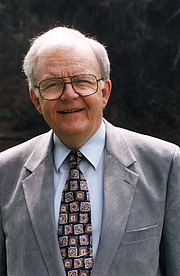A Treasure Found In A Faithful Legacy
Review: ‘Calling Our Cities to Christ’ by Roger S. Greenway
At Radius Global Cities Network, one of our main priorities is to help bridge what we see to be a significant resource gap in the evangelical missions landscape when it comes to urban engagement. We believe that through our provision of cutting edge, high-quality urban research and data, practitioners around the world can have access to an arsenal of resources that will equip them to more faithfully reach their cities with the Gospel. Let me briefly draw attention to a set of freely available resources from a particular individual offered at RGCN. I will highlight one book from that cache of gems that I believe will embolden city workers to continue pressing into the endless tensions of the city. The Roger S. Greenway Collection Here at Radius, we stand proudly on the ‘shoulders’ of Roger S. Greenway, late theologian and urban missiologist. We have been privileged by the Greenway family to house a collection of his writings from a variety of his publications. It is our hope that this current generation of urban ministers will be introduced to his faithful legacy of scholarship in the field of urban missiology. In many ways, Greenway was ahead of his time, seemingly ‘prophetic’ in his forecasting of the changing trends in a rapidly urbanizing 20th Century. He was not only a brilliant sociologist of the city, but most notably he was a committed confessional missiologist with a deep conviction for the local church and her role in reaching cities with the Gospel of Jesus Christ. Calling Our Cities to Christ by Roger S. Greenway[1] If you were to do a simple Google search for Roger S. Greenway’s complete corpus of books, a lengthy list would appear displaying his seminal as well as lesser-known works. But there is one missing pearl that seems to have vanished from existence. We at Radius Global would love to bring it back. As a matter of fact, it is important that we do so. Calling Our Cities to Christ, is short book that Greenway wrote in 1974. In its 129 pages, his goal was quite simple. He wanted to add to the mission’s conversation of his day a book that addressed “urban evangelism from a Calvinist standpoint” (ix). Greenway writes from the confident assumption that Calvinists stand in a long legacy of faithful missionaries, evangelists, and church planters. In this book more specifically, Greenway discusses the role of the local church as the primary space for effective evangelism in the changing neighborhoods of urban areas. Here are three apex features that you will want to encounter further as you read the book. 1. Repentance is the Goal of Urban Missions Greenway gets right into the nitty gritty by beginning a discussion about repentance. He harkens us back to the story of Jonah as the first biblical account of urban evangelism. Remember when God told the prophet Jonah to “Arise, go to Nineveh, that great city and call out against it, for their evil has come up before me.” Understanding the magnitude of that order, how tall of an order that was, Jonah took off running. You know the story, after some time in the bowels of a giant fish, Jonah returns to Nineveh a penitent man. Eager this time to obey the Lord he calls the sin-ridden city to repentance. Greenway says that “in view of the imminency of the city’s destruction” this call to repentance “was the most gracious thing he could have done” (3). The storehouse of God’s mercy pours out through repentance. You see, repentance was the only hope for the Ninevites, and Greenway reminds us that it is still the only hope for our cities. What an amazing privilege we have to preach a more complete message today than Jonah, a message of Good News to our cities. Greenway encourages us to see that we have a more joyful proclamation found in the completed Word of God that reveals the coming of a great Savior, one who desires that “no one should perish but that all should come to repentance” (2 Peter 3:9). He unapologetically zeros in on the main goal of urban missions. He challenges us to see that “it is the task of God’s servants to call the whole city to repentance” (5). He posits to us that if God demanded repentance for the whole of Nineveh, then a broad sweeping repentance is what He desires for our cities today. Our proclamation of repentance and faith in the Gospel of Christ, is one that is sufficient to touch the whole of society, one that “will be seen in everything the city is and does” (6). May the Lord build churches that preach the whole Gospel to the whole of our cities. 2. Church History Matters in Urban Missions Greenway takes a large chunk of the book surveying the history of Protestantism in American urban centers. He briefly addresses the first significant mass movement wave into cities at the end of the 19th Century into the turn of the 20th Century. From the dawn of America to the point of these earliest large urban migrations, Protestantism had long been rural in orientation. Greenway speaks of an “anti-urban bias” which remained from the post-Civil War period until the very moment and time of this book. He asserts that this partiality had greatly hurt effective urban evangelism and was largely wrapped up in “elements, both religious, cultural and racial” (21). This, of course, left poor urban churches with the unavoidable reality of poverty and suffering in their cities. Greenway critiques the pace at which Protestantism responded to these needs. Urban American churches in the late 19th-beginning 20th Centuries were largely disengaged from the plight of suffering in their cities. Into this gap stepped the para-church movement. It was the slum workers of the Salvation Army, Volunteers of America, and the Rescue Mission movement that stepped around the churches to minister to the depressed, poor and vulnerable. These ministries were kind enough to report back to the churches, but sadly “the urban church was more like a solitary cathedral, estranged and alienated” (26) from its surrounding environment. Greenway gives a balanced assessment of the benefits and weaknesses in the quick rise of the para-church movement, but he, of course, turns his focus back to the activity of the urban church during this time. Greenway also does an excellent job showcasing influential figures in the urban missions movement, like James E. Yeatman, a “statesman, industrialist, and philanthropist” (42). It was Yeatman who recaptured an ecclesiology that fueled a right missiology. He wanted to put before denominations and lay people a vision that reflected the New Testament pattern of churches functioning as the primary center for Christian mission in the city. He believed that city churches were “launching centers for strategic urban missions” (43). 3. The Local Church is at the Center of Urban Missions The hallmark strength of Calling Our Cities to Christ, is Roger Greenway’s ecclesiocentrism. As underscored in his book over and over again, when urban mission is detached from robust biblical ecclesiology, it has no sustaining power. The local church is God’s primary design for reaching cities with the Gospel. Greenway states forthrightly, “There can be no kingdom citizenship nor kingdom activities where there are no members of Christ’s church” (97). And we can see from history that when urban workers lose sight of the true gospel proclaimed in faithful churches, the results of their labor are disciple-less. Mouths may have been fed in a humanitarian enterprise, and praise God for that, but were disciples made? We also know that when local churches detach deed from their Gospel proclamation, the results once again are disciple-less. Greenway helps us see the fuller picture of a biblical Gospel proclaimed that can redeem whole hearts in whole neighborhoods through the age-old means of repentance and faith, word and deed. In the final chapter, Greenway ties everything back to what he calls “A Reformed Approach To Today’s Cities” (103). He reminds us that both “presence and proclamation are essential for urban missions.” Evangelism has not taken place unless the verbal presentation of the gospel is clearly delivered. May we never grow satisfied by our mere presence. An Important Rediscovery This short read is filled with a substance that I believe transcends changing generations in a changing world. This is perhaps what makes this book such an important rediscovery for urban workers today. But it is not without some bumps as well. Greenway can sometimes overgeneralize and make assertions that are too simplistic, particularly when speaking about “racial attitudes and class pride” (113). Greenway also makes some generalizations about racial groups that are quite monolithic (121). Though these aspects of his writing need more nuance, the examples do not detract from the importance of his main points. Greenway polishes off this gem of a book with a homage to the historic Reformed Tradition and its advantages to the formation of faithful urban strategy. He contends that Calvinism offers a “full Gospel which requires the total renewal of man and his society, and it is the only Gospel which offers any genuine hope for today’s urban world” (112). Greenway pities that more Calvinists do not recognize this. What an opportunity that reformed city churches have to stand in a long legacy of confessional faithfulness. And, would we pray that the Lord would bring a multitude of reformed churches to our cities, churches that are “composed of neighborhood people, whatever their cultural or racial background may be” (115), churches that are filled with disciples of our Lord Jesus Christ. ___________________________

